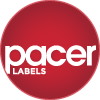
What factors differentiate a beautiful and professional-looking label from a label that looks poorly made and unprofessional? One of these factors is the use of a printer bleed. But what exactly is a printer bleed?
To help you navigate this concept, we’ve put together this guide to explain what printer bleeds are, why they are essential to your design, and some of the terminology you will encounter in the label printing industry regarding printer bleeds.
A bleed is when you design your artwork to extend (or “bleed”) beyond the actual dimensions of the label. The purpose of a bleed is to ensure that your label prints to size and the graphic fully covers the printed space from edge to edge. A bleed allows you to have margin-less labels that look sharp and crisp.
If you don’t use a bleed, chances are you will see a small white border on the outer edge of your piece. Sometimes this border is thinner and thicker in places, and sometimes it disappears based on how the label is printed and cut. This unwanted white border can make your label look crooked, cheap, and almost like you printed your label on a home printer.
Now that you know what a bleed is, it’s important to understand two additional terms closely related to this concept: trim zone and safety zone. When you receive the recommended artwork specifications for printing your labels, you will likely hear these terms used in the printing industry.
Here is what each term means:

A standard bleed is typically 1/8 (or .125) of an inch. You will want to ensure that your graphic, colors, or other artwork elements cover the entire bleed area. But, be careful not to extend important elements into the bleed area of they will be cut out.
You can also use a 1/8-inch margin to separate the padding trim and the safety zones. However, it is common to extend this interior padding even further based on your label’s design.
A bleed may extend up to 1/4 (or .25) inches for larger labels or special print configurations. When you’re working with a printer, they will typically provide you with any specific bleed requirements based on your artwork. If they don’t, stick with the standard bleed size.
To recap: the safety zone is the interior part of your label where your content can safely live without being trimmed or cut too closely. The trim zone is where the blade will cut your piece. And the bleed is space beyond the trim line your graphic needs to cover to ensure a clean and crisp edge of your label.
As always, if you have questions about setting up your label artwork, our experts are eager and willing to help! Give us a call at 888.391.3575 and let’s get started on your custom labels today! Pacer Labels takes pride in providing its clients with personal customer service because every custom label job requires custom care!
Protected by Security by CleanTalk

